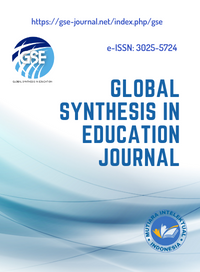Developing a Social‑Media-Based Manufacturing Engineering Drawing Teaching Module to Improve Students’ Skills
DOI:
https://doi.org/10.61667/scpfch12Keywords:
Engineering Education, Instructional Design, Manufacturing drawing, Social media learning, Student Skill, Technology enhances learning.Abstract
The increasing integration of technology in education has brought forth innovative ways to enhance the learning of complex skills. This study explores the development of a social-media-based teaching module for manufacturing engineering drawing aimed at improving students’ technical skills dynamically and engagingly. The research follows a design-based approach, utilizing the ADDIE (Analyze, Design, Develop, Implement, Evaluate) instructional design model to create a modular curriculum delivered through a social media platform (Instagram and YouTube). The study evaluates the effectiveness of this module by conducting a quasi-experimental pre-post test with 120 engineering students from a Vocational High School. Data were analyzed using paired-sample t-tests and qualitative thematic analysis to assess skill improvement and student engagement. Results indicate a statistically significant improvement in students’ manufacturing drawing skills, with an average skill gain of 15% (p < 0.001). Qualitative findings highlight the positive impact of social media on peer collaboration, real-time feedback, and increased engagement. The module’s design was validated through expert reviews, achieving a content validity index (CVI) of 0.88. The findings suggest that social media can provide an effective and scalable platform for teaching technical subjects, facilitating enhanced interaction and knowledge retention. This study contributes to the literature on technology-enhanced learning and offers practical recommendations for educators seeking to incorporate social media into manufacturing engineering curricula.
References
Albin-Clark, J. (2024). Digitally doing Reggio: mobilising posthuman pedagogical knowledge co-creation with socially mediated performativities of early childhood education. Pedagogy, Culture and Society, 32(4), 1099–1108. https://doi.org/10.1080/14681366.2024.2355093
Arifin, M. A., & As’Ad, M. S. (2019). Student engagement, collaborative learning, and flipped classroom as a basis for a blended language learning environment. Asian EFL Journal, 24(4), 38–44. https://www.scopus.com/inward/record.uri?eid=2-s2.0-85068593356&partnerID=40&md5=750c1af578af617f208c014a72d85896
Bergdahl, N., Nouri, J., & Fors, U. (2020). Disengagement, engagement and digital skills in technology-enhanced learning. Education and Information Technologies, 25(2), 957–983. https://doi.org/10.1007/s10639-019-09998-w
Bond, M., & Bergdahl, N. (2023). Student Engagement in Open, Distance, and Digital Education. In Handbook of Open, Distance and Digital Education (pp. 1309–1324). Springer Nature. https://doi.org/10.1007/978-981-19-2080-6_79
Brown, A. and, & Green, T. (2018). Issues and Trends in Instructional Technology: Consistent Growth in Online Learning, Digital Content, and the Use of Mobile Technologies. In: Branch R. (eds) Educational Media and Technology Yearbook. Educational Media and Technology Yearbook, Springer, Cham, 41, 61–71. https://doi.org/10.1007/978-3-319-67301-1_5/j.edutec.2018.041
Chan, F. F. Y. (2020). The effectiveness of integrating facebook in marketing communications learning and teaching. Journal of Interactive Learning Research, 31(3), 219–237. https://www.scopus.com/inward/record.uri?eid=2-s2.0-85101874028&partnerID=40&md5=8014c465e7e224861dd8fda110a99363
Chao-Fernandez, R., Román-García, S., & Chao-Fernandez, A. (2017). Online Interactive Storytelling as a Strategy for Learning Music and for Integrating Pupils with Hearing Disorders into Early Childhood Education (ECE). Procedia - Social and Behavioral Sciences, 237(June 2016), 17–22. https://doi.org/10.1016/j.sbspro.2017.02.005
Claro, M., Salinas, A., Cabello-Hutt, T., San Martín, E., Preiss, D. D., Valenzuela, S., & Jara, I. (2018). Teaching in a Digital Environment (TIDE): Defining and measuring teachers’ capacity to develop students’ digital information and communication skills. Computers and Education, 121, 162–174. https://doi.org/10.1016/j.compedu.2018.03.001
Cohen, A., & Soffer, T. (2015). Academic Instruction in a Digital World: The Virtual TAU Case. Procedia - Social and Behavioral Sciences, 177(July 2014), 9–16. https://doi.org/10.1016/j.sbspro.2015.02.322
Cress, U., Stahl, G., Rose, C., Law, N., Ludvigsen, S., Sousa, M. J., Rocha, Á., Bunker, B., Brown, A. and, Green, T., Demir, M., Suwana, F., Lily, Iconaru, E. I., Ciucurel, C., Dankbaar, M. E. W., Richters, O., Kalkman, C. J., Prins, G., … Christiaens, T. (2018). Issues and Trends in Instructional Technology: Consistent Growth in Online Learning, Digital Content, and the Use of Mobile Technologies. In: Branch R. (eds) Educational Media and Technology Yearbook. Educational Media and Technology Yearbook, Springer, Cham, 17(1), 61–71. https://doi.org/10.1007/978-3-319-67301-1_5
de Klerk, S., Veldkamp, B. P., & Eggen, T. J. H. M. (2018). A framework for designing and developing multimedia-based performance assessment in vocational education. Educational Technology Research and Development, 66(1), 147–171. https://doi.org/10.1007/s11423-017-9559-5
de Koster, S., Volman, M., & Kuiper, E. (2017). Concept-guided development of technology in ‘traditional’ and ‘innovative’ schools: quantitative and qualitative differences in technology integration. Educational Technology Research and Development, 65(5), 1325–1344. https://doi.org/10.1007/s11423-017-9527-0
Green, A. H. B. dan T. D. (2016). The Essential of Instructional Design. Connecting Fundamentals Principles With Process and Practice. Routledge.
Hanafi, Y., Murtadho, N., Ikhsan, A., & Diyana, T. N. (2020). Reinforcing public university student’s worship education by developing and implementing mobile-learning management system in the ADDIE instructional design model. International Journal of Interactive Mobile Technologies, 14(2), 215–241. https://doi.org/10.3991/ijim.v14i02.11380
Harianto, G. P., Rusijono, R., Masitoh, S., & Setyawan, W. H. (2020). Collaborative-cooperative learning model to improve theology students’ characters: Is it efective? Cakrawala Pendidikan, 39(2), 409–421. https://doi.org/10.21831/cp.v39i2.31272
Hidayati, A., Bentri, A., & Yeni, F. (2020). The Development of Instructional Multimedia based on Science, Environment, Technology, and Society (SETS). In R. null, I. Ifdil, Y. Yohandri, K. null, Z. Ardi, & R. Rahim (Eds.), Journal of Physics: Conference Series (Vol. 1594, Issue 1). Institute of Physics Publishing. https://doi.org/10.1088/1742-6596/1594/1/012016
Joshi, D. R., Adhikari, K. P., Khanal, B., Khadka, J., & Belbase, S. (2022). Behavioral, cognitive, emotional and social engagement in mathematics learning during COVID-19 pandemic. PLoS ONE, 17(11 November). https://doi.org/10.1371/journal.pone.0278052
Kazanidis, I., Pellas, N., Fotaris, P., & Tsinakos, A. (2019). Can the flipped classroom model improve students’ academic performance and training satisfaction in Higher Education instructional media design courses? British Journal of Educational Technology, 50(4), 2014–2027. https://doi.org/10.1111/bjet.12694
Khan, A., Ahmad, F. H., & Malik, M. M. (2017). Use of digital game based learning and gamification in secondary school science: The effect on student engagement, learning and gender difference. Education and Information Technologies, 22(6), 2767–2804. https://doi.org/10.1007/s10639-017-9622-1
Kirschner, P. A., Sweller, J., Kirschner, F., & Zambrano, J. R. (2018). From Cognitive Load Theory to Collaborative Cognitive Load Theory. International Journal of Computer-Supported Collaborative Learning, 13(2), 213–233. https://doi.org/10.1007/s11412-018-9277-y
Luthfi, M. I., & Wardani, R. (2019). Application of design thinking in designing history instructional media for high school students. International Journal of Advanced Science and Technology, 28(16), 698–710. https://www.scopus.com/inward/record.uri?eid=2-s2.0-85081190548&partnerID=40&md5=1afc543bfdb24f983759c74a59d3498e
Makitan, V., Glušac, D., Kavalić, M., & Stanisavljev, S. (2024a). The socio-digital engagement of adolescents and their cognitive—Educational needs a case study: Serbia. Computers and Education Open, 6, 100170. https://doi.org/10.1016/j.caeo.2024.100170
Makitan, V., Glušac, D., Kavalić, M., & Stanisavljev, S. (2024b). The socio-digital engagement of adolescents and their cognitive—Educational needs a case study: Serbia. Computers and Education Open, 6, 100170. https://doi.org/10.1016/j.caeo.2024.100170
Miaz, Y., Helsa, Y., Febrianto, R., & Erwin, R. (2019). The development of interactive multimedia-based instructional media for elementary school in learning social sciences. Journal of Physics: Conference Series, 1321(3). https://doi.org/10.1088/1742-6596/1321/3/032107
Nonthamand, N. (2024). Designing the video-based learning environments using workflow and scaffolding to enhance self-instructional video production ability of pre-service teacher. Contemporary Educational Technology, 16(1). https://doi.org/10.30935/cedtech/14102
Prasetya, F., Fortuna, A., Jalinus, N., Refdinal, R., Fajri, B. R., Wulansari, R. E., Primawati, P., Andriani, W., Samala, A. D., Luthfi, A., Putra, W. P., Ayasrah, F. T. M., & Kaya, D. (2024). Revolutionizing CNC Lathe Education: Designing Instructional Media Integrated Using Augmented Reality Technology. TEM Journal, 13(2), 1695–1701. https://doi.org/10.18421/TEM132-82
Pu, Y.-E. A., & Barnard, R. (2025). Teacher and Learner Agency for Collaborative Learning: Academic Writing in a Blended Environment. In Teacher and Learner Agency for Collaborative Learning: Academic Writing in a Blended Environment. Taylor and Francis. https://doi.org/10.4324/9781032643144
Raghavendra, P., Hutchinson, C., Grace, E., Wood, D., & Newman, L. (2018). “I like talking to people on the computer”: Outcomes of a home-based intervention to develop social media skills in youth with disabilities living in rural communities. Research in Developmental Disabilities, 76(December 2017), 110–123. https://doi.org/10.1016/j.ridd.2018.02.012
Razak, R. A. (2013). Shared Mental Model Among Graphic Designers , Multimedia Designers and Subject Matter Experts in Designing Multimedia- based Instructional Media. Procedia - Social and Behavioral Sciences, 103, 818–825. https://doi.org/10.1016/j.sbspro.2013.10.403
Rohana, A. K., Cristyn, R., Nugraha, A. E., Harsanto, K., & Lee, G. (2022). Design of Spectrum Analyzer Android-based Instructional Media for Vocational High School Student. Proceeding - IEEE International Conference on Communication, Networks and Satellite, COMNETSAT 2022, 361–367. https://doi.org/10.1109/COMNETSAT56033.2022.9994494
Saini, C., & Abraham, J. (2019). Implementing Facebook-based instructional approach in pre-service teacher education: An empirical investigation. Computers and Education, 128, 243–255. https://doi.org/10.1016/j.compedu.2018.09.025
Salonen, A. O., Tapani, A., & Suhonen, S. (2021). Student Online Activity in Blended Learning: A Learning Analytics Perspective of Professional Teacher Education Studies in Finland. SAGE Open, 11(4). https://doi.org/10.1177/21582440211056612
Sangsawang, T. (2015). Instructional Design Framework for Educational Media. Procedia - Social and Behavioral Sciences, 176, 65–80. https://doi.org/10.1016/j.sbspro.2015.01.445
Sinaga, M. P., & Manik, Y. (2023). A design of E-learning instructional media for system thinking and system simulation courses. In N. Ishartono, Y. Sidiq, E. Sudarmilah, V. N. Fikriyah, & A. D. Anggono (Eds.), AIP Conference Proceedings (Vol. 2727). American Institute of Physics Inc. https://doi.org/10.1063/5.0141403
Stahl, G. (2015). Conceptualizing the intersubjective group. International Journal of Computer-Supported Collaborative Learning, 10(3), 209–217. https://doi.org/10.1007/s11412-015-9220-4
Swart, W., & Macleod, K. (2021). Evaluating learning space designs for flipped and collaborative learning: A transactional distance approach. Education Sciences, 11(6). https://doi.org/10.3390/educsci11060292
Tai, J. H.-M., Bellingham, R., Lang, J., & Dawson, P. (2019). Student perspectives of engagement in learning in contemporary and digital contexts. Higher Education Research and Development, 38(5), 1075–1089. https://doi.org/10.1080/07294360.2019.1598338
Tim, Y., Pan, S. L., Bahri, S., & Fauzi, A. (2017). Digitally enabled crime-fighting communities: Harnessing the boundary spanning competence of social media for civic engagement. Information and Management, 54(2), 177–188. https://doi.org/10.1016/j.im.2016.05.006
Uma, S. (2023). Conversational AI chatbots in digital engagement: Privacy and security concerns. In Trends, Applications, and Challenges of Chatbot Technology (pp. 274–317). IGI Global. https://doi.org/10.4018/978-1-6684-6234-8.ch012
Vincent, E. O., & Udeme, T. A. (2014). Instructional strategies and students academic performance in electrical installation in technical colleges in Akwa Ibom State: Instructional skills for structuring appropriate learning experiences for students. International Journal of Educational Administration and Policy Studies, 6(5), 80–86. https://doi.org/10.5897/ijeaps2014.0347
Waljinah, S., Dimyati, K., Prayitno, H. J., Dwilaksana, C., Rufiah, A., & Purnomo, E. (2020). The study of euphemism in social media: Digital technology-based learning media innovation. International Journal of Innovation, Creativity and Change, 12(2), 172–184. https://www.scopus.com/inward/record.uri?eid=2-s2.0-85083050393&partnerID=40&md5=f7acaa3044540cde318f60674a7a468c
Wang, W. (2024). Optimization of the path of industry-teaching integration in vocational education based on ADDIE model. Applied Mathematics and Nonlinear Sciences, 9(1). https://doi.org/10.2478/amns-2024-0505
Downloads
Published
Issue
Section
License
Copyright (c) 2025 Global Synthesis in Education Journal

This work is licensed under a Creative Commons Attribution-NonCommercial-ShareAlike 4.0 International License.




















